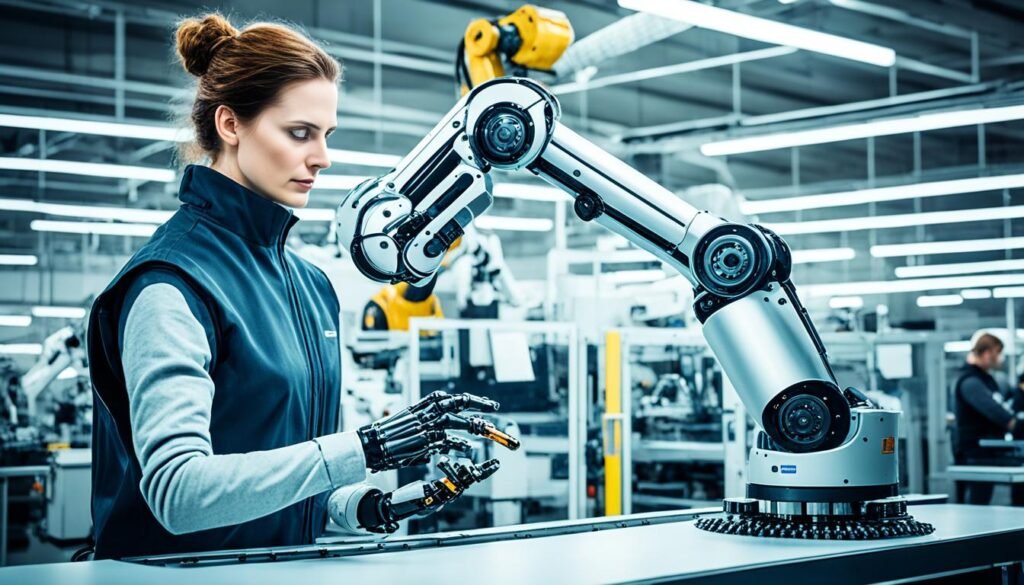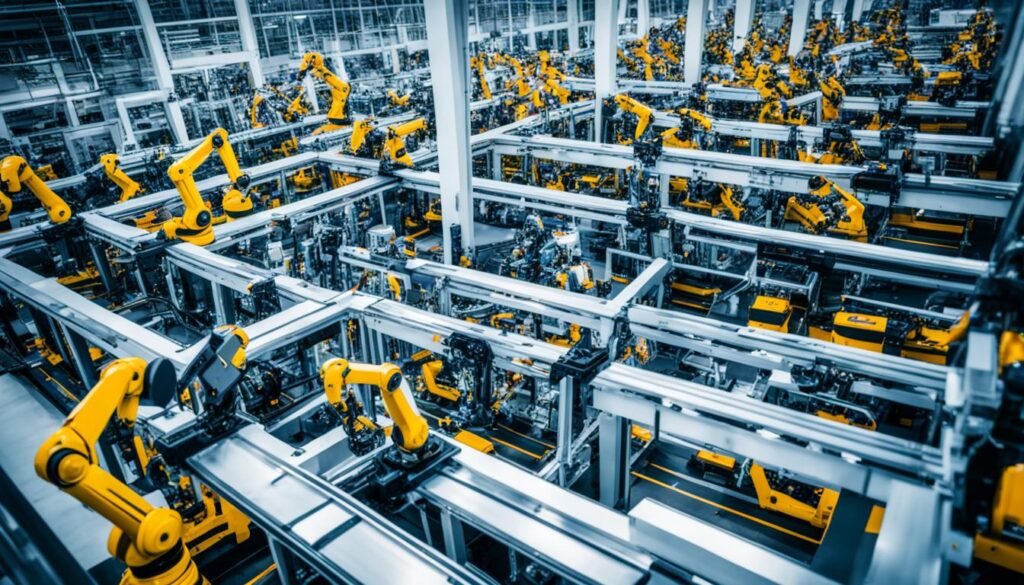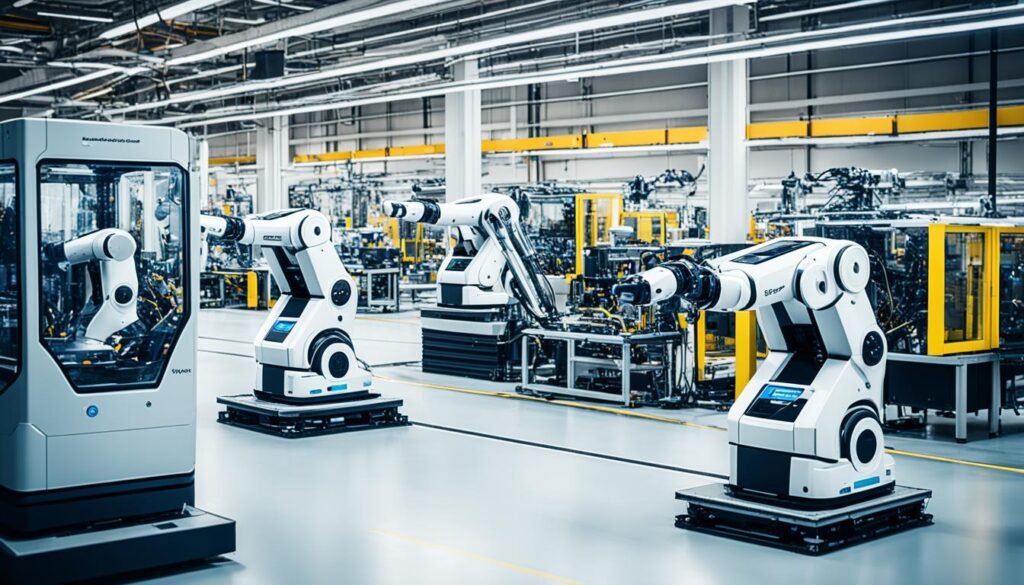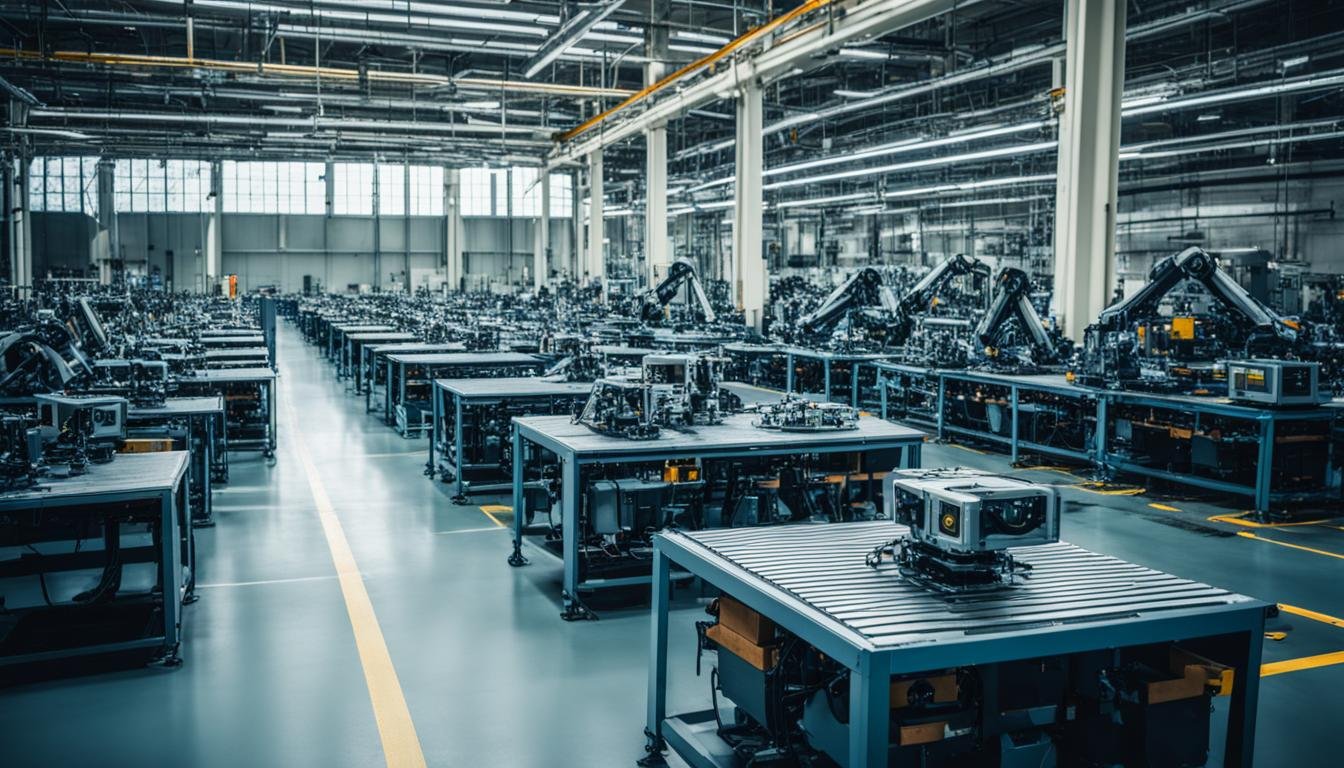Get ready for a shocking fact: a recent report says McKinsey forecasts up to 45 percent of work could be automated. This includes simple and routine tasks. AI and automation are changing the job market in big ways.
Three professors from the University of Cincinnati’s Carl H. Lindner College of Business are studying this change. They are experts in operations, business analytics, and information systems. Their research shows how AI will change the workforce, bringing both challenges and chances for the future of work.
Key Takeaways
- AI and automation could replace millions of jobs, with estimates suggesting 85 million to 800 million workers might lose their jobs by 2030.
- Jobs that involve repetitive, manual tasks are more likely to be automated. But, jobs that need human creativity and problem-solving are safer.
- AI will affect jobs in two ways: by automating tasks and by making human tasks better. The latter will boost human skills in complex tasks.
- Learning new skills and developing “soft” skills like communication and critical thinking will be key to keeping up with job changes.
- It’s important for policymakers, tech leaders, and workers to work together to make the transition smoother and ensure workers come out on top.
Introduction to AI and Automation
Definition and History of AI
Artificial Intelligence (AI) is a field that aims to make machines do tasks that need human smarts, like learning and solving problems. It started in the 1950s when scientists looked into how computers could think like humans.
The Rise of Automation and its Impact on Labor
Automation has grown thanks to AI and other tech advances. It means using machines and software to do jobs once done by people. This makes many industries work better and faster, but it also worries people about losing jobs.
Recent studies show that 37% of companies using AI have replaced workers with the technology. And 44% of companies expect AI to lead to job cuts in 2024. Yet, experts say some jobs might not need humans in the next five to 10 years. But, human skills like leadership and creativity are still key and can’t be replaced by AI.
| Jobs at Risk of Automation | Jobs Less Likely to be Replaced by AI |
|---|---|
|
|
Automation’s effect on jobs is complex, with both good and bad sides. As AI and automation keep getting better, we need to understand how they change the job world. We must also find ways to adjust and succeed in this new setting.
Job Displacement and Disruption
The fast growth of artificial intelligence (AI) has made people worry about losing their jobs. The fear of losing jobs to AI is real, but the actual effect might not be as bad as we think. New data shows the impact might not be as big as feared.
About 23% of jobs related to vision could be automated, but many tasks aren’t likely to be taken over by AI soon. This is because some jobs don’t make sense to automate right now, based on cost. But, automation might speed up as AI gets cheaper and more companies offer AI services.
| Trend | Impact |
|---|---|
| Reductions in AI system costs | Increased pace of AI adoption and automation |
| AI-as-a-service platforms | Widespread access to AI technologies across industries |
AI is great at doing tasks that are repetitive and simple. But, it’s not a simple story for jobs. Jobs like data entry, customer service, and basic analysis might see fewer people needed. This is because of chatbots and virtual assistants.
But, AI isn’t just affecting simple jobs. Some jobs could see big losses, making income differences worse. On the other hand, jobs needing advanced tech and analysis skills are growing. This is making jobs more divided.

There aren’t many programs to help workers learn new skills. AI can also carry biases from the data it uses, which can unfairly affect hiring. This can make things harder for some groups.
Workers are also feeling the mental effects of AI. The worry of losing a job, not knowing what the future holds, and less human interaction can cause stress and anxiety. It can also make people feel less sure about their jobs and their purpose.
AI’s Dual Impact: Automation and Augmentation
AI is changing the job market in two ways – automation and augmentation. AI automation aims to replace human tasks with AI. On the other hand, ai augmentation uses AI to boost human abilities.
The Path of Automation
The path of automation believes AI can do tasks as well as or better than humans. This idea is big in the US tech world. Companies like Microsoft and Google are always working on new AI tools to automate more tasks.
This ai automation trend could make things worse. It might increase the gap between the rich and the poor, and lead to fewer good jobs. As AI gets better, it might replace human jobs instead of just helping them, making some jobs disappear.
“According to the World Economic Forum’s Future of Jobs Report, by 2025, 85 million jobs may be displaced by automation, while 97 million new roles are projected to emerge.”
But, automation also brings new chances. New jobs will come up focused on using and improving AI. Being able to adapt and keep learning will be key for people in the changing job world.
Companies will need to value creativity and innovation more as automation takes over. They should use the good parts of ai automation while also dealing with its downsides.
How AI is Taking Over Jobs
AI is changing the job market and will continue to do so in the future. AI systems are getting better at doing tasks that humans used to do. Jobs that involve routine tasks or simple data work are at risk of being automated.
Automation has already taken away 1.7 million jobs since the 2000s. By 2025, AI could take away 85 million jobs. The Industrial Revolution showed how technology can greatly improve the economy, and AI is doing the same thing now.
PwC predicts up to 30% of jobs could be automated by the early 2030s. Jobs in manufacturing, retail, and transportation are at high risk. Even in translation, AI tools have cut down on income for translators.
But not all jobs will be replaced by AI. Jobs that need complex problem-solving, creativity, and a human touch are safe. For example, jobs in healthcare, education, and the arts are unlikely to be fully automated.
AI will also create new jobs. The World Economic Forum says AI will create 2.3 million new jobs by 2025. Companies are training their employees to work with AI and automation.
After COVID-19, creating jobs is still a challenge, especially in low-income areas. Policymakers must make sure AI benefits everyone. They should support workers with training programs.

“More than 85% of businesses consider big data, cloud computing, and AI essential for their development and success.”
AI will keep changing the job market. While some industries might decline, others will grow with AI’s help. The “augmentation” approach, where AI helps humans, offers hope for the future of work.
The Path of Augmentation
The threat of losing jobs to ai augmentation is real, but there’s a brighter side. Enhancing human capabilities is a path that’s full of promise. Instead of replacing humans, AI can help make us better together.
Picture a world where AI gives workers better information and insights. This could be for anyone, from factory workers to office professionals. With more data and analysis, they could do their jobs better and take on new challenges. This could open up new opportunities they never thought possible.
This isn’t just for office jobs. Jobs in healthcare, education, and skilled trades can also get a boost from AI. By giving workers better tools and advice, they can focus on what humans do best. Things like creativity, understanding people’s feelings, and solving complex problems.
As AI gets better, we’ll need to find a balance. We must use technology to make humans better, not just replace them. By training workers for new skills, we can make sure they’re ready for the future. This way, AI and humans can work together, creating new things and growing the economy.
“The rise of AI and automation doesn’t have to be a zero-sum game between humans and machines. With the right approach, we can create a future where AI enhances and empowers human capabilities, rather than replacing them entirely.”
The Impact on Different Industries and Job Types
Artificial intelligence (AI) is changing the job scene across many fields. It’s especially affecting manufacturing jobs, white-collar jobs, and knowledge work.
Manufacturing and Labor-Intensive Jobs
AI and automation are reshaping manufacturing. They make things more efficient and productive. In China, AI has led to more jobs, not fewer. In fact, jobs in AI, big data, and manufacturing grew by about 30% each year from 2019 to 2022.
But, AI is also replacing jobs that are repetitive or need simple tasks. A study by MIT and Boston University warns that AI might take over two million manufacturing jobs by 2025.
White-Collar and Knowledge Work
AI is also changing white-collar and knowledge work. It’s automating tasks like checking rules or simple data entry. A report by McKinsey & Company says AI could lead to new jobs like AI Trainers and Data Analysts.
But, not all jobs are at risk. Jobs that need creativity or problem-solving skills, like teaching or law, are safer. The World Economic Forum says AI will mainly affect manufacturing jobs. But, healthcare and education will see more job growth.
| Industry | Impact of AI | Job Trends |
|---|---|---|
| Manufacturing | Increased efficiency and productivity | Growing number of jobs in AI, big data, and manufacturing industries |
| White-Collar and Knowledge Work | Automation of routine tasks | Creation of new job roles in AI, data analysis, and management of human-machine collaboration |

AI’s effect on jobs is complex, with both ups and downs. As AI grows, workers, employers, and policymakers must adapt. This will help ensure a smooth change and create new, good job chances.
Challenges and Opportunities
AI is changing the workforce, bringing both challenges and chances. Reskilling and upskilling workers are key to keep up with new job demands. New jobs and industries are also opening up, offering great chances for those ready to learn.
Reskilling and Upskilling the Workforce
AI might automate many jobs, so workers need new skills to stay ahead. Reskilling workforce for AI and upskilling workforce for AI are crucial. Companies should invest in training to help workers adjust to new job needs.
New Job Creation and Emerging Industries
AI might replace some jobs, but it also creates new jobs created by AI in fields like data analytics and machine learning. These areas are growing fast, offering many chances for skilled people. By seeing AI’s potential, individuals can get ready for the future job market.
| Potential Job Losses | Potential Job Gains |
|---|---|
| – 45 million Americans could be out of work by 2030 due to AI – 1 billion individuals globally could lose their jobs to AI – 9% to 47% of jobs at risk of automation |
– 97 million new jobs created by AI by 2030 – Increased demand for AI-related roles like data engineers and software engineers – Opportunities in emerging industries like data analytics and machine learning |
We need a team effort from employers, workers, and policymakers to tackle AI’s challenges and seize its chances. By focusing on reskilling and upskilling, and supporting new AI industries, we can create a workforce ready for the future.
The Role of Policymakers and Stakeholders
Artificial intelligence (AI) is changing the job market fast. Policymakers and stakeholders have a big role in making sure this change is good for everyone. They need to handle policymaker role in ai, regulation of ai, worker protection from ai, and fostering innovation with ai. This ensures a smooth transition and good outcomes for businesses and workers.
Regulation and Worker Protection
Governments need to make policies that balance technology use and development. They should update the tax code to make it fair for both workers and machines. This stops businesses from using automation too much.
Regulatory agencies should listen to workers on how AI and other technologies are used. They should put worker safety and happiness first.
Fostering Innovation and Economic Growth
The government should invest in research on human-complementary AI technology. This creates new jobs and makes workers more productive. Policymakers can also set up a federal AI center to help with AI rules and use.
This center will support lawmakers and officials with AI issues. It will help with innovation and economic growth.
| Policy Area | Key Initiatives |
|---|---|
| Regulation and Worker Protection |
|
| Fostering Innovation and Economic Growth |
|
Policymakers and stakeholders can shape a future where AI and human work together well. This will lead to economic growth and happiness for everyone.

The Future of Work in the Age of AI
AI is changing the future of work fast. The future of work with AI offers new chances but also brings challenges. We need to find a balance between efficiency and employment.
Trends and Predictions
The World Economic Forum says AI will create 2.3 million jobs and cut 1.8 million by 2020. This means more jobs overall because of AI. But, it will also change certain industries and jobs a lot.
Jobs that involve routine tasks or simple data work might be taken over by AI. But AI can also help in healthcare by making diagnoses faster and more accurate. In retail, it helps with personalized customer service and product suggestions.
Balancing Efficiency and Employment
Finding the right balance is key in the AI age. AI can make us more productive but might also take some jobs. In fact, 85 million jobs could disappear by 2025 because of automation.
But, there’s hope. Experts think 97 million new jobs could come up by 2025 with AI and new technologies. The challenge is making sure workers are ready for these changes. We also need to keep creating new jobs and growing the economy to keep employment meaningful.
“The future of work in the age of AI is about finding the right balance between the efficiency gains of automation and the need to maintain meaningful employment.”
Conclusion
AI’s effect on jobs is complex and will shape the future of work. As automation and AI grow, it’s key to use the energy of organized labor wisely. We must see how these technologies can help both workers and companies.
Improving how workers make decisions and solve problems is key. But, big tech and companies won’t change much without pressure. This comes from labor groups, government rules, and civil society.
We need a balanced way to use AI’s benefits. This means making humans better and creating new jobs. It also means making sure workers have the skills and safety they need in this new world. By working together, we can make a future where tech and human work go hand in hand. This will lead to more innovation, productivity, and growth for everyone.
FAQ
What is the impact of AI on jobs?
AI is changing jobs fast, especially those with routine tasks like data entry and simple writing. But, it could also bring new jobs and make humans and technology work better together.
What are the two distinct paths that the AI revolution could take?
There are two main paths for AI’s impact. The first is automation, where AI does tasks as well as or better than people. The second is creating new tasks that humans can do, making us work better with technology.
How can the more hopeful path of augmenting human capabilities be achieved?
To make the best use of AI, we need big changes. First, managers should see workers as valuable assets to be improved. Second, tech companies should focus on helping workers. And third, workers should have a say in how technology is used.
What policies can encourage the human-complementary path of AI development?
To support AI that helps humans, we need policies. This includes changing taxes to make it fair for workers and machines. Also, creating a federal AI center to help lawmakers and officials.
How will AI impact different industries and job types?
AI will hit jobs in manufacturing and labor-intensive fields hard, especially those with routine tasks. But, it could also make jobs in these areas better by making tasks easier and more efficient.
What are the challenges and opportunities presented by AI’s impact on jobs?
AI brings challenges like needing to retrain workers. But, it also opens up new job opportunities in emerging fields. We need policymakers and stakeholders to work together to ensure jobs remain meaningful as automation increases efficiency.
